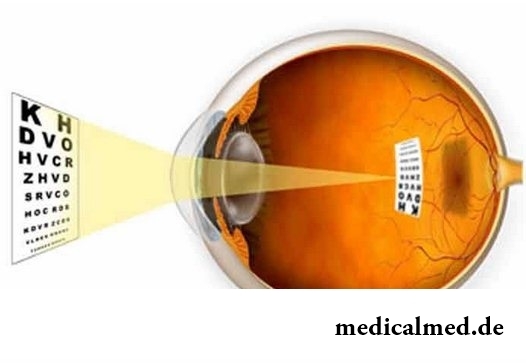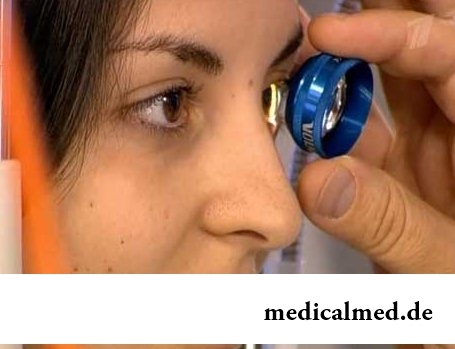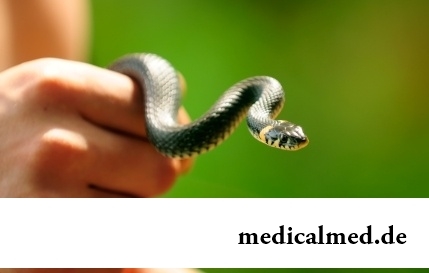





Short-sightedness
General characteristic of a disease

Short-sightedness or myopia is the widespread disturbance of a refraction of an eye leading to the bad clearness of sight. Short-sighted people badly see the objects removed from them. This feature of sight is quite often caused by an abnormal form of an eyeglobe. At short-sightedness it has the oval form therefore focusing of beams happens not on the retina, and ahead of it, and the image turns out indistinct.
Eyeglobe stretching at short-sightedness leads to even more considerable deterioration in sight because of retina dystrophy. It gradually becomes thinner and can become torn or exfoliate as a result of an injury or falling.
Short-sightedness – the disease of the younger generation is preferential. Around the world not less than 1 billion people whose bulk school students students and other persons to 30-year age suffer from it.
Forms, degrees, types of short-sightedness
Children can have an inborn short-sightedness. In this case the child is already born with the broken refraction of eyes and from the earliest age needs correction of short-sightedness.
The hereditary form of a disease is shown from 1 to 18 years at a half of children whose parents suffer from short-sightedness.
Development of the acquired short-sightedness in children of 7-16 years most often is caused by visual work in bad conditions (at the wrong lighting or landing during written works, and also at excessive hobby for the computer). However the disease and in this case is also provoked by hereditary factors - predisposition to weakness of eye muscles and irregular shape of an eyeglobe.
On disease degree of manifestation short-sightedness can be weak (to 3,0 diopter.), average (to 6,0 diopter.) and strong (it is higher than 6,0 diopter.).
Depending on a developmental character of a disease distinguish stationary and progressing types of short-sightedness. At the first type of a myopia sight of the patient is broken, but does not worsen over time. The progressing short-sightedness at children and adults is characterized by continuous decrease in visual acuity to several dioptries in a year.
Diagnosis of short-sightedness
At short-sightedness there are no other explicit morphological changes in structure of organs of sight except an oval form of an eyeglobe. Existence of short-sightedness at children can be suspected, watching behavior of the child: one of explicit symptoms of a myopia – a prishchurivaniye thanks to which the picture becomes more accurate.
The ophthalmologist specifies the diagnosis during check of sight according to Sivtsev's table. The doctor at the same time can use corrective glasses. The physical and clinical refraction of an eye at short-sightedness is checked by means of an oftalmometr, the refractometer and/or a dioptron. For the best visibility of an eyeground to the patient the tsiploplegiya – a mydriasis by atropine or skopalominy is preposted.
To establish an etiology of short-sightedness the ekhooftalmograf is applied. It allows to calculate a sagittal axis of eyes (distance from the center of a retina to visual area). The received results correspond the patient with age, and only on the basis of qualitative and quantitative assessment of a refraction the diagnosis is established and treatment of short-sightedness is planned.
Conservative treatment of short-sightedness

Problem of conservative correction of short-sightedness - without operations only by means of points, contact or hardware techniques to change abnormal a refraction of eyes.
Points – the most traditional way of correction of short-sightedness. At exact selection of lenses it is possible to provide comfortable sight and to eliminate tension of eyes.-Point correction - one of the most widespread techniques of treatment of short-sightedness at children. However it has also shortcomings: inconvenience during sports activities, limitation of peripheral sight, disturbance of space perception and injury risk.
Contact correction of short-sightedness by means of lenses can be applied in the day or night mode. In the second case the corrective lens changes during sleep curvature of a cornea and provides effect of normal sight for all next day.
Lenses for correction of short-sightedness are convenient and capable to improve sight considerably. However it is contraindicated to carry them during infectious diseases. Perhaps also traumatizing an eye or infection at the wrong carrying or use of unsterile lenses.
In hardware treatment of short-sightedness points masseurs, corrective computer programs, ultrasonic, infrared laser and magnetotherapy, vacuum massage, and also electrostimulation are applied. The course of conservative correction of short-sightedness is formed individually, on average for 10 days with serial use to 5 various devices.
It is worth approaching selection of eyeglass lenses extremely responsibly, the low-quality optics can lead to deterioration in symptoms of short-sightedness.
Surgical treatment of short-sightedness
Laser correction of sight — the least dangerous type of operation at short-sightedness. The procedure consists in change of curvature of a cornea with a laser beam. Treatment happens on an outpatient basis to use of a local anesthesia. Low-invasive laser short-sightedness operation lasts up to 60 seconds. Its effect lifelong, and after use of this technique the patient does not need any more optical ways of correction of sight – lenses or points.
Treatment of sight by means of the laser is contraindicated at short-sightedness at children, during pregnancy, a lactation, at a cataract, glaucoma, and also at intensive progressing of a disease. In this case carrying out a scleroplasty is recommended. During it the donor sclera for prevention of further stretching of an eyeglobe is implanted to the patient. And laser correction of sight becomes already following stage in treatment of short-sightedness.
Other look surgical short-sightedness operations a lazerokoagulyation is appointed to the patient at retina dystrophy. This technique does not improve sight, but allows to prevent further thinning, amotio or a rupture of a retina.
Short-sightedness operation with implantation in an eye of a contact lens is performed at contraindications of laser correction of a disease. Material of a lens is compatible to tissues of an eye and has a lifelong warranty. The natural crystalline lens at the same time remains, and permanent improvement sight occurs 5-6 hours later after operation.
Statistically, on Mondays the risk of getting injured of a back increases by 25%, and risk of heart attack – for 33%. Be careful.

Household skills which to us so diligently imparted in the childhood it appears, not always bring only benefit. According to result...
Section: Articles about health
Statistically, at the address to doctors seven of each ten patients complain of a headache. Actually it is much more people who are periodically feeling unpleasant feelings such. Many people, apart from a headache the reason for serious fear...
Section: Articles about health
Heart disease and blood vessels lead to disturbance of blood supply of bodies and fabrics that involves failures in their work, deterioration in health of the person, decrease in its working capacity and standard of living. Annually more than 17 million inhabitants of our planet perish from pathologies such....
Section: Articles about health
About 20% of the population of our planet have a hypertension (permanent increase in arterial pressure). This disease negatively narrations...
Section: Articles about health
(Xerostomia) many people consider feeling of a xerostomia small and easily removable inconvenience. This delusion: the symptom can demonstrate existence of serious diseases. It is worth to remember also that saliva performs important functions...
Section: Articles about health
High temperature - a frequent symptom of such widespread diseases as a SARS, quinsy, pneumonia, etc. To reduce heat, having facilitated a condition of the patient, doctors recommend to accept antipyretics, however their use is not always possible. Too frequent use of these drugs can lead to allergic reactions, and also overdose, causing poisoning. It happens also that there are no antipyretics simply in the house. In these situations it is pertinent to use it...
Section: Articles about health
The naturopathy sometimes moves as the new direction of medicine, something like fashionable hobby, and there is nothing farther from the truth....
Section: Articles about health
There comes the season of issues. Many Russians already dream of outdoor recreation, trips, beautiful seaside beaches. At this time there is no wish to think of problems with health and other unpleasant things, however there are subjects which require attention. Summer...
Section: Articles about health
Sooner or later hair turn gray at all. Many people try to hide these changes, returning natural color of the hair by means of coloring, or considerably changing it for the purpose of creation of absolutely new image. All know that the gray hair is a sign of the coming old age, so, it is necessary to get rid of it....
Section: Articles about health
Zone hypostases under eyes - very widespread problem giving to people is a lot of inconvenience. Hypodermic fabric in these parts having...
Section: Articles about health
For the person who daily since morning gathers for work it is very important to wake up vigorous and ready by day of work. Actually, each of us experiences difficulties with this, at first sight, simple business from time to time. On a condition of an organism after ночн...
Section: Articles about health
Cystitis, or inflammation of a mucous membrane of a bladder, this very widespread disease which, owing to some features of a structure of bodies of urinogenital system, women have approximately four times more often than men. Women aged from 20 up to 45 years enter into the main risk group. Cystitis is an illness of a bacterial origin. It can have an acute or chronic current. The second option is dangerous not only a frequent recurrence, серьезн...
Section: Articles about health
The medicine promptly develops, and the fact that else quite recently it seemed by miracle can now. We are not surprised any more to the fact that sport...
Section: Articles about health
Impossibility to conceive the child – a trouble of many Russian families. During quite long time was considered that main "culprits" of troubles such are women. Modern physicians claim that the situation is different: about a half of failures at...
Section: Articles about health
Urogenital candidiasis (milkwoman) – a fungal infection which annoys unpleasant feelings in the field of generative organs, being followed by white curdled allocations, an itch, discomfort during an urination, pain. She is called by Candida fungus – the opportunistic organism living on mucous membranes of an organism....
Section: Articles about health
Obesity is called by a disease of 21 centuries, for the last 100 years by the number of the people suffering from excess body weight, considerably increased...
Section: Articles about health
Beauty shop – the place which is associated only with positive emotions: joy, pleasure, relaxation. However visit of salon where work with biological material of clients, not always harmlessly is conducted. Today it is known Bol...
Section: Articles about health
There is a lot of fans of beer in our country. Statistically, on each average Russian (including women and children) in a year about 60 liters of this drink are consumed. It is not a lot of, as in the Czech Republic or Germany, but figure all the same impressive. There is nothing to rejoice here: despite assurances of producers that beer is absolutely harmless, effects of its active consumption cannot be considered positive in any way. Here only part of that negative impact, which popular нап...
Section: Articles about health
Among a set of the perfumery and cosmetic goods which are released today the special group is made by the means containing anti-bacterial...
Section: Articles about health
All the known slogan "Protect Men!" arose not from scratch. In a sense, the nature created men much less adapted for vital disorders, than it seems at first sight. Statistically, men are ill more often...
Section: Articles about health
It is pleasant to state a possibility of improvement of quality of life of people with problems of functioning of secretory system. Efforts of talented inventors created products which will be able to provide normal life activity of clients with moderate degree of a disease, it is essential to facilitate the help to patients with strongly expressed disturbances....
Section: Articles about health
Iodine - one of thirty most important microelements in our organism. The main role of iodine consists in synthesis thyroid гормо...
Section: Articles about health
Ayurveda - the most ancient tselitelsky practice which came to us from India. It represents the doctrine about maintenance of physical, psychological and moral health of the person by means of the complex of procedures including a diet, cleaning of an organism, respiratory упр...
Section: Articles about health
The pine is one of the most widespread plants of our woods. Its needles and pitch not without reason called by "gallipot" were since ancient times used for strengthening of protective forces of an organism, treatment of avitaminosis, anemia and many other diseases. In recent years wide popularity was gained by the national medicines prepared from pinecones. "Fruits" of a coniferous tree contain a huge amount of vitamins, biologically active agents, antioxidants, phytoncides and other useful to...
Section: Articles about health
The sclera and mucous membrane of an eye are intensively supplied with blood vessels which problem - to sate nervous tissues of body to a pitata...
Section: Articles about health
The healthy nutrition is the invariable principle of health and good health for long years of the woman. Nevertheless, in a diet at each stage of life there are the features allowing to support an organism by those substances which are most necessary...
Section: Articles about health
Health and attractiveness - eternal values, pursuing which people often use the most unusual ingredients and technicians. Let's consider 11 most exotic and sometimes not most pleasant Spa procedures to which the person in a pursuit of beauty and youth agrees....
Section: Articles about health
